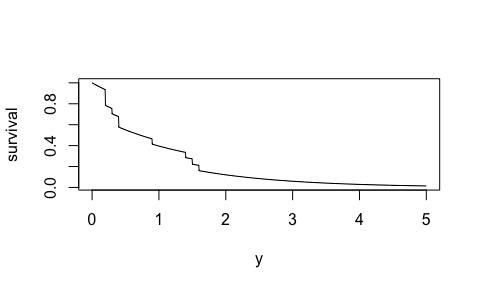distplyr breathes life into probability distributions by providing a grammar for their modification and reshaping. It works seamlessly with distribution objects from the distionary package.
The distplyr package name is inspired by the dplyr R package: whereas distplyr provides a grammar for manipulating distributions, dplyr provides a grammar for manipulating data.
Installation
distplyr is not on CRAN yet, so the best way to install it is:
remotes::install_github("probaverse/distplyr")Basic Usage
Want to model a count variable that starts at 1, not 0? Consider shifting a Poisson distribution.
(d1 <- dst_pois(1.5) + 1)
#> [1] "shift" "dst"
#>
#> components :
#> $distribution
#> [1] "pois" "parametric" "dst"
#>
#> name :
#> [1] "pois"
#>
#> $shift
#> [1] 1Here’s its probability mass function:
enframe_pmf(d1, at = 0:10) |>
plot()
Or, maybe you have positive continuous data and you’d like its tail to continue as an exponential distribution:
x <- c(1.6, 0.9, 0.2, 1.4, 0.4, 0.3, 0.2, 0.4, 0.2, 1.5)
mu <- mean(x)
(d2 <- dst_empirical(x) |>
graft_right(dst_exp(mu), breakpoint = max(x)))
#> Mixture Distribution
#>
#> Components:
#> # A tibble: 2 × 4
#> distributions probs breakpoint include
#> <list> <dbl> <dbl> <lgl>
#> 1 <finite> 0.9 1.6 FALSE
#> 2 <slic_lft> 0.1 1.6 FALSEHere’s the survival function:
plot(d2, "survival", from = 0, to = 5, n = 1000)
Or maybe you’d like to mix the empirical and Exponential distributions:
(d4 <- mix(dst_empirical(x), dst_exp(mu)))
#> Mixture Distribution
#>
#> Components:
#> # A tibble: 2 × 2
#> distributions probs
#> <list> <dbl>
#> 1 <finite> 0.5
#> 2 <exp> 0.5
plot(d4, "survival", from = 0, to = 5, n = 1000)
distplyr in Context
There are a few other R packages that handle probability distributions. The key differentiator with distplyr is its grammar, and the flexibility of the package distionary, which distplyr sits on top of.
Some examples:
- The distributional package also allows for distribution manipulation, but is less flexible, and builds vectorization into the package. distplyr (and distionary) deliberately leaves vectorization up to the user, since distributions can be evaluated to produce a variety of output types.
- Development of distributional appears to have happened at the same time as distplyr, and distributional uses a similar family of functions –
dist_*()– to make probability distributions.
- Development of distributional appears to have happened at the same time as distplyr, and distributional uses a similar family of functions –
- The distr package allows you to make distributions including empirical ones, and transform them, using S4 classes, but the interface is complex. distplyr aims to provide a human-centric interface by providing a grammar.
Acknowledgements
The creation of distplyr would not have been possible without the support of the R Consortium, The Natural Science and Engineering Research Council of Canada (NSERC), The University of British Columbia, and BGC Engineering Inc.
Code of Conduct
Please note that the distplyr project is released with a Contributor Code of Conduct. By contributing to this project, you agree to abide by its terms.
